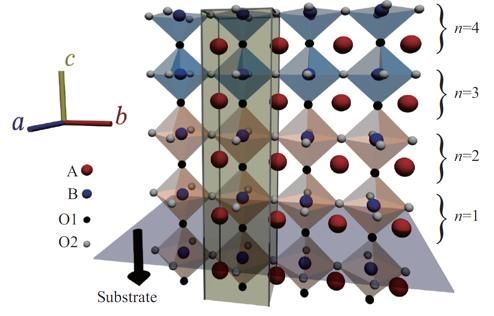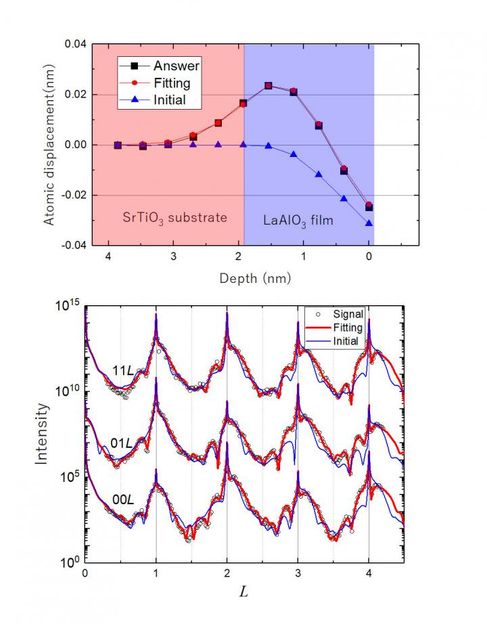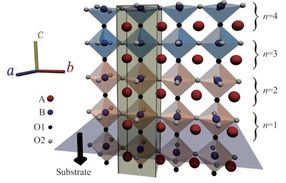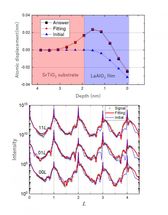Rolling the dice on perovskite interfaces
perovskites are a type of mineral and class of materials, and have been attracting a great deal of attention for their potential applications to technologies such as those used in solar cells. These unique materials have well-ordered structures and show many interesting properties that could be useful in other areas of electronics. Such a variety of properties in the same structural backbone allows different kinds of perovskites, with different properties, to be evenly joined together without breaking lattice coherency. Being able to examine the structures at these interfaces is important for researchers studying perovskites, but currently used techniques have insufficient resolution or produce complex results that are very difficult to analyze.

This is a schematic of perovskite oxide interface.
Osaka University

This is an example of the software performance. (top) Atomic displacement of model structure as a function of depth. (bottom) Scattered x-ray intensity profiles calculated from the model structure (demo-data, open circles), initial structural model (blue curve) and the result of the refinement (red curve). In this figure, the analysis on the demo-data to show the accuracy of the method. The analysis on an experimentally obtained dataset is also reported.
Osaka University


Now, Osaka University-led researchers have found a way to model perovskite oxide interfaces with great precision and accuracy using a new computerized approach to picking out the correct structure from X-ray data.
"Using typical scanning transmission electron microscopy on perovskite oxides requires samples to be cut, which can damage the surface and affect the resolution," study lead author Masato Anada says. "Surface X-ray di?raction approaches avoid these effects but analyzing the data is complex, so few people are using this method. Our Monte Carlo-based refinement method provides a fast way to search for the most probable structure from X-ray data, and is versatile enough to be applied to more variable interfaces."
Monte Carlo methods help predict what the structure of an interface probably looks like. By making small changes, with certain restrictions, many different possible structures can be randomly simulated.
Applying this technique to the interface between perovskites and comparing simulated X-ray data with real measurements allows the researchers to rapidly identify the most likely perovskite structures.
They tested their new method on a simulated X-ray dataset from a realistic interface structure between two types of perovskite oxides, and the final structure refined by their modelling was very close to actual structure of the interface.
"Features of perovskite interfaces are ideal for testing out certain theories in condensed matter physics and for making new types of electronic materials system," coauthor Yusuke Wakabayashi says. "Our approach makes analyzing the complex structural data of these interfaces much easier, and it's also robust for uneven interfacial structures. This approach should be useful for anyone currently investigating these structures."
Original publication
Other news from the department science

Get the analytics and lab tech industry in your inbox
By submitting this form you agree that LUMITOS AG will send you the newsletter(s) selected above by email. Your data will not be passed on to third parties. Your data will be stored and processed in accordance with our data protection regulations. LUMITOS may contact you by email for the purpose of advertising or market and opinion surveys. You can revoke your consent at any time without giving reasons to LUMITOS AG, Ernst-Augustin-Str. 2, 12489 Berlin, Germany or by e-mail at revoke@lumitos.com with effect for the future. In addition, each email contains a link to unsubscribe from the corresponding newsletter.




















































